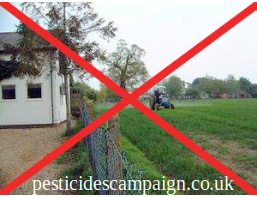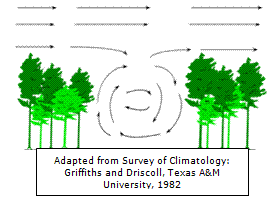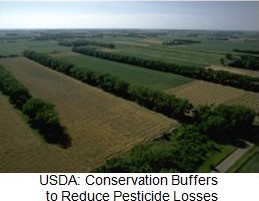
Potential problems before you make the application to identify sensitive areas such as susceptible crops, beehives, wetlands, bodies of water, houses, and inhabited areas (i.e. schools, hospitals). Applicators must know the direction of prevailing winds and exactly what lies downwind of the application. During any application, some droplets may be carried downwind from the application site.
Prior to any pesticide application, evaluate the site. Scope out and document pot
Topography
The topography of an area can create microclimates where the temperature, wind, airflow, and humidity may be quite different from adjacent areas. Some locations are more likely to develop temperature inversions or to channel drift downslope, and cause injury over long distances. Analyze every site carefully, and consider weather conditions before making any pesticide application.
Windbreaks

Wind patterns around a windbreak
Windbreaks and shelterbelts are plantings of rows of trees or other tall and dense vegetation. One purpose of such buffers is to protect sensitive areas from spray drift.

Set-backs
Set-backs are untreated buffer zones where surface runoff and drift can be intercepted and avoid contamination of streams or other sensitive areas. Seeding these areas to perennial grass improves pesticide trapping compared with the “trapping efficiencies ” of untreated row crop. Buffer sizes vary depending upon the pesticide being used, the sensitivity of the area, and other drift management practices employed. Consult the pesticide label to ensure that any specific buffer requirements are followed.

Set-back (NRCS)
Initial compilation courtesy of Jim Wilson, PhD
